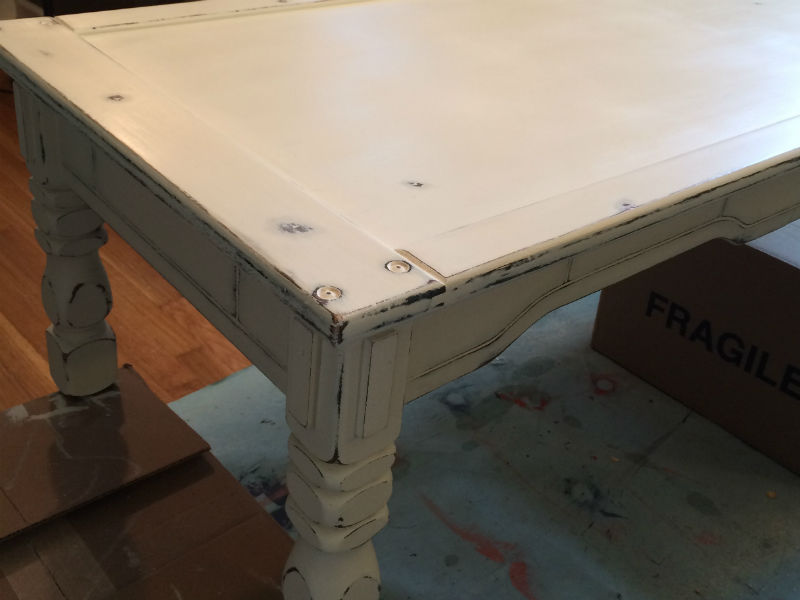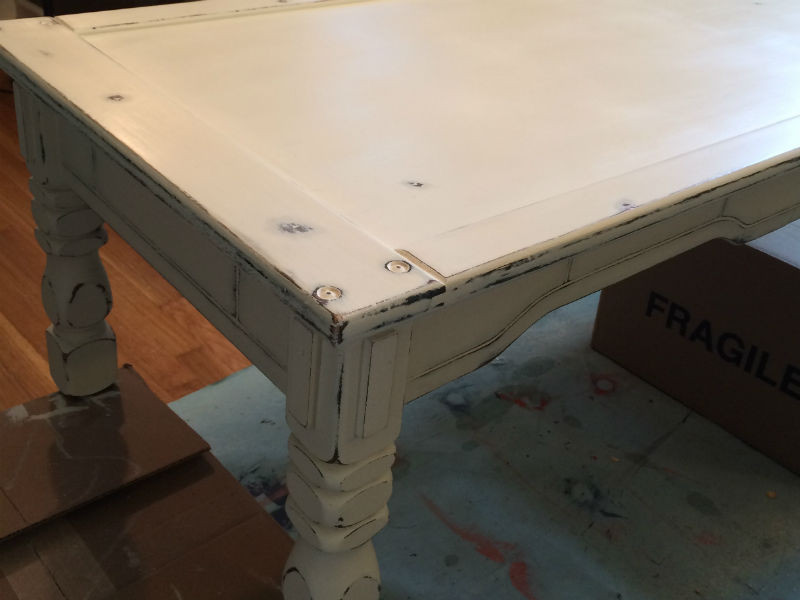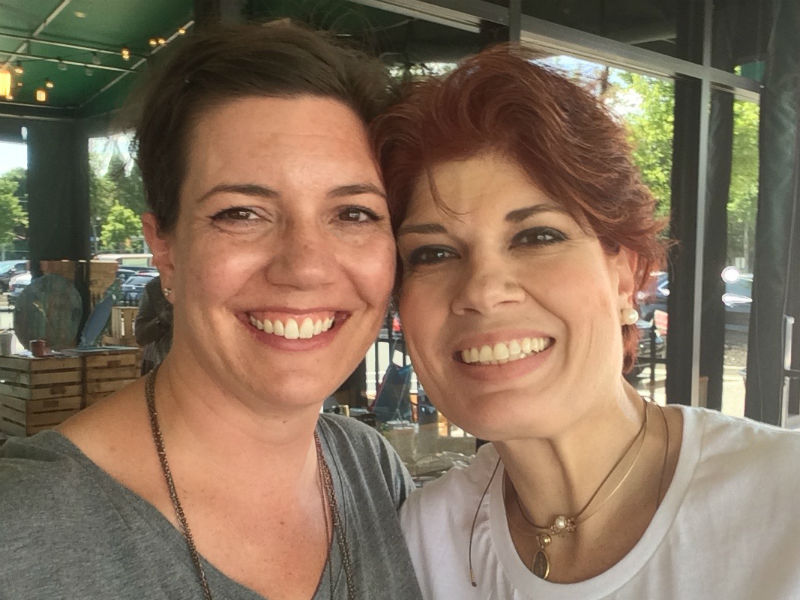
I don’t use wax to seal chalk paint on furniture. Man, it feels freeing to say that. Everything I know about painting furniture I have learned through trial and error, and also reading other painters’ blogs. From the time I began using chalk paint and similar paints, everything I’ve read and everyone I’ve talked to says wax is the go-to finish to seal your chalk paint. That is until I met Maria Revollo of ML Furniture Decor. Maria and I met at a painting workshop she was hosting to teach her Bermuda Blending technique.
Why I Don’t Use Wax To Seal Chalk Paint
Here are my issues with wax finishes. I know there will be some out there who disagree, and I’m ok with that. I welcome you to share your opinions regarding waxes and top coats in the comments below.
- Applying wax is a fairly laborious process, in my opinion. It is an arm work out and a half. I will sometimes finish painting a piece of furniture and then it will sit in my workshop for a week or more because I am dreading finishing it with the wax. (I’m sure part of that is due to me having a little bit of a lazy bone. ;))
- No matter how many blogs or FAQ’s I read about applying a wax finish, videos I watch on how to do it right, etc., I’m never totally happy with the finish. I end up with visible streaks or pieces of the cloth I’m using/brush bristles in the finish. This is particularly troublesome with darker paint colors.
- The cure time is NOT realistic for commission projects. Annie Sloan wax suggests a 30-day period to allow the finish to completely cure and harden. I do believe that the finish is very durable once it is fully cured. However, if I am restyling a piece of furniture for a client, I want them to be able to take it home and use it right away. It feels odd to tell them they need to wait 30 days to use their newly painted furniture like normal.
- The TN humidity this summer just won’t let the wax cure! I painted a coffee table for dear friends and the poor people are STILL waiting for that wax to fully cure and harden. Y’all, it has been THREE months!! The last time I was over I confessed my newly-admitted displeasure with wax finishes and offered to apply a different top coat for them. It’s just unacceptable.
- You can’t paint over a waxed piece. If I get tired of the color of a piece I’ve painted and I’ve waxed it to seal the paint, I have to first remove the wax before I can paint over the piece. What a chore!! With a polycrylic topcoat you could just give it a light sanding and paint right over it!
What’s The Alternative To Wax For Sealing Chalk Paint?
Note: Links in this post are affiliate links and I receive a small compensation when you purchase product via these links. Thank you for supporting my blog!
So now that you know my reasons for giving up on wax finishes, you may be wondering what finishes I DO like to use. My go-to top coat is Wise Owl Varnish. It’s available in matte or satin sheen, which in my opinion are the only two options you need when hand painting furniture.
This product is easy to apply, dries quickly, is very durable, and the furniture can be used as normal almost right away! (Technically there is still a 30-day cure time, but the finish is dry enough to handle within 24 hours.) I had used poly top coats before and was happy with the results. But for some reason I still felt like I had to use wax as my go-to because that’s what I kept reading in all my research. Maria uses a polycrylic-type top coat on ALL her pieces. I think it’s genius and I am so grateful to her for helping me see the light! It isn’t that she “preaches” to always use polycrylic, it’s just what she prefers and I decided if it’s good enough for her then it’s good enough for me! Thanks Maria! 😉
Wax As An Accent
I can’t say that I will never use wax again (partly because I still have about half a can of it that is unused and that stuff is too expensive to just throw out!), but the varnish top coats are definitely first choices for commission projects. I should probably also clarify that I’m just talking about wax as the final finish. There are lots of fun colored waxes out there that I will still use for adding dimension and texture.
And I also love Wise Owl Furniture Salve. Not for sealing paint (which it can be used for), but for reviving raw wood to it’s natural grain and color. I love to use this on the inside of the drawers of my pieces to freshen them up and make them smell amazing. Got a thrifted piece that smells musty? After cleaning it well, apply a scented version of the Furniture Salve to deodorize and neutralize the odor plus give your client a pleasant surprise of goodness when they open the drawers!
As I said earlier, I am sure there are some of you who love wax and will disagree with my opinions. That’s what makes us all unique and I welcome your thoughts in the comments. Thanks for reading!
Want my guide to choosing Wise Owl Paint products? Sign up here and get it delivered to your inbox!
I respect your privacy and will not sell your email address to 3rd parties. You will only receive emails from me about my furniture painting adventures. 🙂



I have used Polycrylic many times with great satisfaction. I even used it on the hardwood (plywood) floors I put in our home (with dogs) over a year ago. It has held up great. Not a fan of the wax either.
Wow, Amy! I’m impressed it held up on your floors. Thanks for sharing!
I agree with all your points and especially your comment that wax is expensive. I think branded chalk paint has been very trendy and that sometimes influences people’s decisions to use it. Recently I’ve found artists who make their own paint and produce incredible works – both with furniture and other types of home decor. I use the wax I have left to mix with paint or stain to create distressed or accent effects. Again, cheaper than buying a lot of different colored waxes. I appreciate this post and you’re willingness to express an opinion outside of what’s popular! Thanks!
Interesting idea to mix the paints with the wax. I may have to try that! Thanks for your encouragement!
I use a poly type finish as well. For the antique look that wax provides I now use glazes. Much more durable.
Hi and thank you for the post. One question the GF Flat out Flat is oil based I was wondering if you’ve experienced any yellowing effect to the paint. I’m hoping not. ????
Hi Tammy, General Finishes Flat Out Flat is actually water based. I’ve just started using the Flat Out Flat so fingers crossed for no yellowing! Here is a link to the product I’m using: https://generalfinishes.com/retail-products/water-based-top-coats-sanding-sealers/flat-out-flat-self-cross-linking-acrylic-topcoat#.V9Nu6pMrLPA.
I am one of those furniture painters that make their own chalk paint 🙂 I also use Minwax finishing paste wax which seems to cure faster . I also add stain to give an antique look to pieces. I can not afford to use the brand name paints and waxes. I would have to up the prices on what I sell LOL . But just may have to try these two products you mentioned.
Let me know what you think if you do try them!
I have just started using GF products which I love. One question though … I like painted bases with wood tops. The Flat Out Flat seems too dull for the top. Is there a wayto shine that up a bit? I’ve used High Performance as well but it’s shinier than the look I’m trying to achieve. Thanks.
Hi Kathie, the High Performance Topcoat is available in four different sheens – Flat, Satin, Semi-Gloss, and Gloss. I would recommend trying the Satin finish for a little bit of shine. Another topcoat I like from General Finishes, especially for large surfaces such as a dining table, is the Gel Topcoat. So much easier to apply and the finish is a hand-rubbed, not too shiny look. I would test that one on a practice surface first to see how you like it. I would love to know which one ends up working for you. Good luck!
Hello. I want to paint my kitchen cabinets. I don’t want it to be shinny. I was wondering if General Finishes Flat Out Flat would work on the cabinets, and the durability with all the things that get on kitchen cabinets. GF HP Satin is glossy to me. Thanks for your help. Ronda
Hi Ronda, I definitely think that either the GF HP or the Flat Out Flat could stand up to the durability needed on kitchen cabinets. GF does make a flat sheen in the HP Topcoat line so you could do either that or the Flat Out Flat. Good luck with your project!
Hi April, thanks so much for this post. Honestly, as many times as I’ve used wax, I have never been satisfied with the results! I’ve tried every which way, and really believed it was me doing something wrong! PS I’ve been refinishing furniture for almost 40 years… I used to sell my furniture on consignment at a shop that was an Annie Sloan stockist, so I was required to represent her products in my work. I used to cheat by adding a little mineral spirits to the wax. It helped a bit but still not great. I recently starting using the whole line of General Finishes products and there’s no way I will ever wax again! Flat Out Flat is the best product I have ever used! Their gel stains are amazing, milk paints are amazing and all the top coats are fabulous and sooo easy to work with. Thanks so much for reaffirming that I’m not incompetent!
Hi Kathy! Thanks for stopping by! I know people who LOVE finishing with wax. I’m just not one of them. 🙂 And 40 years! Go girl! I could certainly learn a trick or two from YOU! And, yes, Flat Out Flat is simply the best. Love ALL the General Finishes products! Wanting to do things different from the majority doesn’t make us incompetent, it makes us individuals with our own ideas about how to get the job done well. 🙂
April- I agree with all your points. The question I have is I want to hit the lows in the detail of a piece of furniture BUT I don’t want to change the overall color of the piece. I researched the Heirloom Traditions gel wax as you can use water and wipe back living the color in the lows. Anyhoo, I think want to put on a finish such as a poly or one of the GF products you mentioned. Can I seal with a non wax product over the Heirloom Traditions gel wax? What do you know? What is your experience. Great article! Thanks for sharing all your thoughts.
Hi Jennifer! Heirloom Traditions gel wax will work well for what you are trying to accomplish. I would suggest only applying it to the areas that have the details you want to highlight, not over the entire piece. Then of course, you would wipe it back from the high areas and the color will stay in the low areas. And, yes, you should be able to use a water-based poly top coat over HT gel wax because it is water based (thus the ability to wipe it back with a damp cloth and clean it up with soap and water). I have not yet tried this, but I know from using the gel wax that it does not at all have the waxy, sticky feel that other waxes have. Also, a general rule of thumb is that water-based products can be used over other water-based products with no issue. Thanks for reading! I hope that helps!
Hi you chalk paint lovers & wax users or not as the case may be.
Well with a number of pieces of pine furniture in our bungalow I decided to attempt to change the look of all but one at a time and start with the smallest first. I was somewhat confused whether I should paint on with chalk paint or roller it on. I was not impressed with my first coat by brush. A friend has painted beds, side units, wardrobes, chest of drawers and they look brilliant. What she told me was like me she is good at painting walls both with a brush and roller but every piece of her furniture has been done with a roller except for the slim sections where it was necessary to use a brush. So off I went to Wilkinsons and bought a roller, tray and some spare rollers. Brilliant. It gives a great surface and no brush marks. So thank friend for that. Oh by the way it also took her weeks to do all her painting. Then I have come to the stage of waxing. So many different options and opinions so I guess its all trial and error and no one way as I been reading. So my tin of clear wax is in the post. This is where I need help.
I have read and watched a number of videos how to paint with chalk paint and then wax. I have also watched people demonstrating how to do stencilling. Maybe I missed something but none of the people demonstrating said the order in which you wax as opposed to when you do stencilling. As in (1) I appreciate you wax your piece of furniture first – wiping off excess as the demonstrators advise (2) Do you then start your stencilling next and then remove stencil letting the pattern to dry (3) Then wax over the stencilling or not as the case maybe. Do I just stencil and leave it but NOT wax over the top of the stencilled pattern. i.e. if I do will the wax remove all the pattern ? Perhaps someone could let me know by leaving a comment.
Hi Anne, I admit I am not experienced at all in stenciling on furniture. However, the general rule of thumb is that wax is always the very last thing you do if you choose to wax. The same would apply to any other topcoat you might choose to use. You would probably want to seal whatever product you used to paint on the stencil and so a wax or topcoat would need to be applied over the stencil as well. As long as your chalk paint is dried thoroughly your stencil should not rub off with application of wax or topcoat. If you are waxing I would just be gentle on the stenciled area just in case for the first pass over it until you are sure it is sealed. Then maybe apply a second coat for extra protection. I hope this helps.
Q. When using the polyacrylic over caulk paint are you applying more then one coat. And if so is it necessary to to sand w/ 220 grit between each.
Thank you
Hi Donna, I always apply at least two coats of polycrylic because you will miss some spots on the first coat and the second coat will help you get full coverage. For areas such as the top of a dresser I would do three coats for extra protection. You should do a very light sanding with 220 grit between coats for a smooth finish. Hope that helps!
Hi April,
I have been painting with ASCP for years. I have also been using GF flat out flat as my top coat. My technique was to put a coat of shellac on before painting to prevent bleed thru. It worked well. But the last year or so as soon as I put on the top coat the paint would crackle. My stockists couldn’t figure it out. Any ideas?
Hi Julie, this has happened to me before as well. One theory I have heard is that the alcohol in the shellac could affect the dry time of the paint and cause it to crackle. I have stopped using shellac and instead always use Wise Owl Stain Eliminating Primer (it’s water based) when I need something to block tannins or help with paint coverage with lighter colors or reds. Hope that helps.